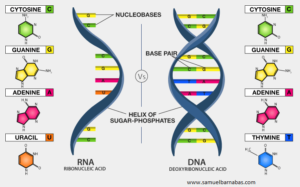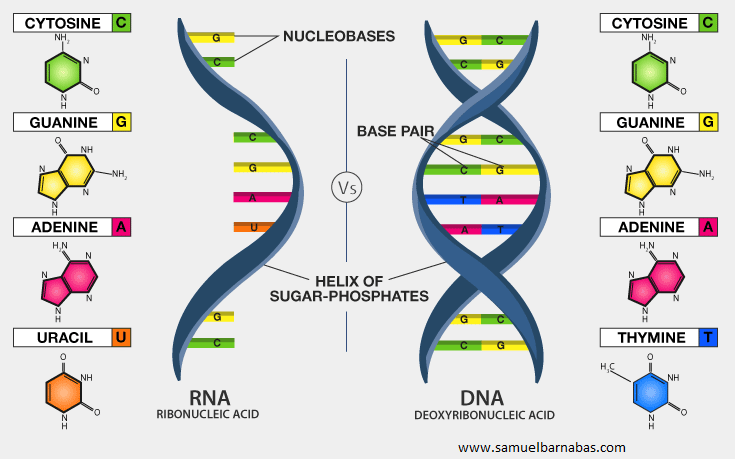Life on Earth displays an immense variety, ranging from single-celled protozoans to intricate multicellular plants and animals. However, at the molecular level, all life shares a fundamental similarity, being composed of the same essential building blocks – DNA and RNA. One key distinction between DNA and RNA is that DNA is double-stranded, while RNA is single-stranded.
Read further to delve into the detailed differences between DNA and RNA.
Differences Between DNA and RNA
Following are the important differences between DNA and RNA:

DNA and RNA Difference
| DNA (Deoxyribonucleic acid) | RNA (Ribonucleic acid) |
| Definition | |
| DNA is a long polymer with a backbone composed of deoxyribose sugar and phosphate groups, featuring four distinct bases: thymine, adenine, cytosine, and guanine. | Is a polymer with a ribose and phosphate backbone with four varying bases: uracil, cytosine, adenine and guanine. |
| Location | |
| It is located in the nucleus of a cell and in the mitochondria. | It is found in the cytoplasm, nucleus and in the ribosome. |
| Sugar portion | |
| It has 2-deoxyribose. | It has Ribose. |
| Function | |
| The primary function of DNA is to transmit genetic information, serving as a medium for long-term storage of genetic instructions. | RNA is critical for the transmission of the genetic code that is necessary for protein creation from the nucleus to the ribosome. |
| Predominant Structure | |
| DNA is a double-stranded molecule composed of a long chain of nucleotides. | RNA is a single-stranded molecule which has a shorter chain of nucleotides. |
| Propagation | |
| DNA replicates on its own, it is self-replicating. | RNA does not replicate on its own. It is synthesized from DNA when required. |
| Nitrogenous Bases and Pairing | |
| The base pairing is as follows: GC (Guanine pairs with Cytosine) A-T (Adenine pairs with Thymine). | The base pairing is as follows: GC (Guanine pairs with Cytosine) A-U (Adenine pairs with Uracil). |
DNA
Within cells, DNA (Deoxyribonucleic acid) serves as the nucleic acid blueprint for synthesizing proteins. DNA comprises the sugar deoxyribose, phosphates, and a distinct sequence of nitrogenous bases: adenine (A), guanine (G), cytosine (C), and thymine (T).
Brief Insight into the Structure and Composition of DNA
The DNA molecules contain the instructions necessary for a living organism’s growth, development, and reproduction. These instructions are housed within each cell and are passed down from parents to offspring.
Composed of nucleotides, which consist of a nitrogenous group, a phosphate group, and a sugar group, DNA’s genetic code is determined by the sequence of nitrogenous bases: thymine (T), guanine (G), cytosine (C), and adenine (A).
Genes are formed by the arrangement of these nitrogenous bases within DNA, which is crucial for protein synthesis. RNA, another nucleic acid, translates this genetic information into proteins from DNA.
The nucleotides join together to form two long strands that twist around each other, creating a structure known as the double helix, reminiscent of a ladder. In this structure, the sugar and phosphate molecules make up the sides, while the bases form the rungs.
The bases on one strand pair up specifically with bases on the other strand: guanine with cytosine, and adenine with thymine.
Due to their extreme length, DNA molecules must be tightly packaged to fit inside cells. They are coiled tightly to form structures called chromosomes. Each chromosome contains a single DNA molecule. In humans, there are 23 pairs of chromosomes found within the nucleus of cells.
Main article: DNA Structure
Types Of DNA
A-DNA: Under conditions of 75% relative humidity or in environments with higher salt concentrations such as K+, Na+, Cs+, or during dehydration, A-DNA maintains a structure with 11 nucleotide pairs per helical turn, rising 2.56Å vertically per base pair. It possesses the widest helical diameter among all DNA forms, measuring 23Å. A-DNA is a right-handed helix with a rotation of 32.70° per base pair.
B-DNA: The most prevalent form, found in the majority of DNA under neutral pH and physiological salt concentrations, is the B-form. It features 10 base pairs per helical turn, with a helical diameter of 20Å and a vertical rise of 3.4Å per base pair. The Watson-Crick double helix model defines the B-form of DNA.
C-DNA: Observed at a relative humidity of 66% and in the presence of select ions such as Lithium (Li+), C-DNA typically exhibits around 9.33 base pairs per turn. It has a helical diameter of approximately 19Å, with a vertical rise of 3.320Å per base pair in the right-handed helix.
D-DNA: Rarely observed, D-DNA is an extreme variant characterized by its negative tilt of 8 base pairs from the helix axis, with an axial rise of about 3.03Å.
Z-DNA: Found in environments with very high salt concentrations, Z-DNA is a unique left-handed helical structure. Its backbone forms a zig-zag pattern due to the sugar-phosphate linkage, where the recurrent monomer is the dinucleotide, as opposed to the mononucleotide observed in other DNA forms.
RNA
RNA, or Ribonucleic Acid, is a nucleic acid that plays a crucial role in protein synthesis. It serves as a messenger, carrying instructions from DNA to control the synthesis of proteins in all living cells.
Composed of long chains of nucleic acids, RNA consists of the sugar ribose, phosphates, and four nitrogenous bases: adenine (A), guanine (G), cytosine (C), and uracil (U). While DNA and RNA share the nitrogenous bases A, G, and C, thymine (T) is typically exclusive to DNA, whereas uracil (U) is specific to RNA.
Types Of RNA
Some genes in cells are transcribed into RNA. Here are the different types of RNA, each encoded by specific genes:
- tRNA – Transfer RNA, known as tRNA, transports amino acids to ribosomes during translation.
- mRNA – Messenger RNA, or mRNA, carries the genetic information for encoding amino acid sequences of a polypeptide.
- rRNA – Ribosomal RNA, or rRNA, combines with ribosomal proteins to form ribosomes, the organelles responsible for translating mRNA.
- snRNA – Small nuclear RNA, or snRNA, forms complexes with proteins used in RNA processing in eukaryotic cells.
Explore More: Structure of RNA
Role Of Protein
In the context of cellular function, it’s important to note that some proteins act as enzymes, facilitating cellular processes by catalyzing chemical reactions. These reactions occur when the enzyme binds to its substrate at the active site, a region of the enzyme that matches the substrate in size, shape, and chemical properties.
The specific size, shape, and chemical properties of an enzyme’s active site are determined by the arrangement of its amino acids, the building blocks of the protein. For a cell to effectively produce an enzyme, it must have precise control over the arrangement of amino acids during the synthesis of proteins.
Proteins are crucial for a cell’s ability to thrive and adapt to its environment. They are used by cells to maintain their structure and to speed up vital chemical reactions such as photosynthesis and respiration.
Without the reliable production of necessary proteins, a cell’s survival is compromised, highlighting the critical role that proteins play in cellular life processes.
More to Read: Proteins
Further Reading
Frequently Asked Questions
What is the composition of DNA and RNA?
DNA and RNA are nearly identical polymers of nucleotides, differing primarily in their base pairs. In DNA, the base thymine is present, while RNA substitutes thymine with uracil. This small variation in nucleotide composition distinguishes the two nucleic acids.
Where are DNA and RNA found?
DNA is primarily located in the nucleus of a cell, where it is responsible for storing the genetic information of the cell. Additionally, DNA is also found in the mitochondria, where it plays a crucial role in the cell’s energy production processes.
On the other hand, RNA is more versatile in its distribution within the cell. It can be found in the cytoplasm, where it participates in various cellular processes such as protein synthesis. RNA is also present in the nucleus, where it is involved in processes like transcription. Moreover, RNA molecules are integral components of ribosomes, which are the cellular machinery responsible for protein synthesis.
How does propagation occur in DNA and RNA?
DNA is capable of self-replication but RNA cannot self-replicate instead, it is synthesized from DNA (DNA transcription) when required.
What is the similarity between DNA and RNA?
Three out of the four nitrogenous bases in DNA and RNA are the same (cytosine, adenine, guanine). They both possess a phosphate backbone to which the bases attach.
Why is DNA a better genetic material than RNA?
The deoxyribose sugar of DNA contains one less oxygen-containing hydroxyl group. DNA is a more stable nucleic acid. RNA, on the other hand, contains ribose sugar and is more reactive than DNA. Therefore, DNA is a better genetic material than RNA.
Which plant hormone is helpful in making RNA and protein?
The plant hormone cytokinin helps in the synthesis of protein and RNA. It functions naturally in conjunction with auxins. In the presence of auxins, it promotes cell division and development. It enables awakening seeds from their dormancy.

